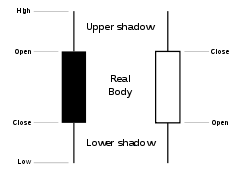What are CandleStick Charts?
CandleStick charts is a style of bar-char used to indicated the price movements of a security over a period of fixed time.
It is a combination of a line-chart and a bar-chart, in that each bar represents the range of price movement over a given time interval. It is most often used in technical analysis of equity and currency price patterns. They appear superficially similar to error bars, but are unrelated.
History of CandleStick Charts
Candlestick charts are said to have been developed in the 18th century by legendary Japanese rice trader Homma Munehisa. The charts gave Homma and others an overview of open, high, low, and close market prices over a certain period. This style of charting is very popular due to the level of ease in reading and understanding the graphs. Since the 17th century, there has been a lot of effort to relate chart patterns to the ldata points instead of one. The Japanese rice traders also found that the resulting charts would provide a fairly reliable tool to predict future demand.
It was during mid 1700’s CandleStick trading became more refined. Candlestick analysis had been developed over the years simply due to the tracking of rice price movements. However, in the mid 1700’s they were really fully utilized. “The god of the markets” Homna came into the picture. Munehisa Homna, the youngest son of the Homna family, inherited the family’s business due to his extraordinary trading savvy. This at a time when the Japanese culture, as well as many other cultures, thought it common that the eldest son should inherit the family business. The trading firm was moved from their city, Sakata, to Edo (Tokyo). Homna’s research into historic price moves and weather conditions established more concrete interpretations into what became known as Candlesticks. His research and findings, known as “Sakata Rules” became the framework for Japanese investment philosophy.
The method was picked up by Charles Dow around 1900 and remains in common use by today’s traders of financial instruments.
Build of a CandleStick Chart

A CandleStick charts are made of a block of rectangle known as the body that is either black or white, and an upper and a lower shadow. The upper and lower Shadows are nothing but the line’s that represent the high and low of a candle (these lines are commonly know as wicks). The body illustrates the opening and closing trades. If the security closed higher than it opened, the body is white or unfilled, with the opening price at the bottom of the body and the closing price at the top. If the security closed lower than it opened, the body is red (filled), with the opening price at the top and the closing price at the bottom. A candlestick need not have either a body or a wick.
Candlestick patterns
There are multiple forms of candlestick chart patterns, with the simplest depicted at right. Here is a quick overview of their names:
![]()
1. White candlestick – signals uptrend movement (those occur in different lengths; the longer the body, the more significant the price increase)
2. Black candlestick – signals downtrend movement (those occur in different lengths; the longer the body, the more significant the price decrease)
3. Long lower shadow – bullish signal (the lower wick must be at least the body’s size; the longer the lower wick, the more reliable the signal)
4. Long upper shadow – bearish signal (the upper wick must be at least the body’s size; the longer the upper wick, the more reliable the signal)
5. Hammer – a bullish pattern during a downtrend (long lower wick and small or no body); Shaven head – a bullish pattern during a downtrend & a bearish pattern during an uptrend (no upper wick); Hanging man – bearish pattern during an uptrend (long lower wick, small or no body; wick has the multiple length of the body.
6. Inverted hammer – signals bottom reversal, however confirmation must be obtained from next trade (may be either a white or black body); Shaven bottom – signaling bottom reversal, however confirmation must be obtained from next trade (no lower wick); Shooting star – a bearish pattern during an uptrend (small body, long upper wick, small or no lower wick)
7. Spinning top white – neutral pattern, meaningful in combination with other candlestick patterns
8. Spinning top black – neutral pattern, meaningful in combination with other candlestick patterns
9. Doji – neutral pattern, meaningful in combination with other candlestick patterns
10. Long legged doji – signals a top reversal
11. Dragonfly doji – signals trend reversal (no upper wick, long lower wick)
12. Gravestone doji – signals trend reversal (no lower wick, long upper wick)
13. Marubozu white – dominant bullish trades, continued bullish trend (no upper, no lower wick)
14. Marubozu black – dominant bearish trades, continued bearish trend (no upper, no lower with no lower wick)
Latest Query
- by Sam
Search Our Archives
Research Desk
- Stocks Trading above their 50 day moving average - DMA In Stock Research
- Download free Ebooks based on Technical Analysis In Personal Training
- TOP 100 Stocks with the Highest P/E as on July 14th, 2013 In Stock Research
- TOP 100 Stocks with the Lowest P/E as on July 14th, 2013 In Stock Research
- Charting Pathsala - Your guide to Techincals In Technical Analysis





